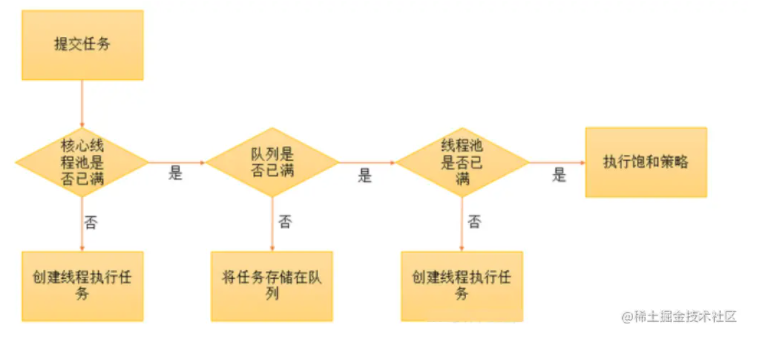详解Java ThreadPoolExecutor的拒绝策略
背景
线程池的技术在项目中使用广泛,线程池提供了四种拒绝策略,大家是否了解这四种拒绝的策略呢?本文将详细的讲解ThreadPoolExecutor的四种拒绝策略,以及相关的注意事项。
线程池基本原理
线程池的原理如下图:

说明:
- 当前运行的线程少于corePoolSize,则创建新线程来执行任务。
- 运行的线程等于或多于corePoolSize,则将任务添加到队列中。
- 当任务队列已满,则在非corePool中创建新的线程来处理任务。
- 创建新线程将使当前运行的线程超出maximumPoolSize,任务将被拒绝,并调用RejectedExecutionHandler.rejectedExecution()方法。
线程池拒绝策略
线程池为我们提供了四种拒绝策略分别是:CallerRunsPolicy,AbortPolicy,DiscardPolicy,DiscardOldestPolicy
AbortPolicy
ThreadPoolExecutor中默认的拒绝策略就是AbortPolicy直接抛出异常,具体实现如下
public static class AbortPolicy implements RejectedExecutionHandler {
public AbortPolicy() { }
public void rejectedExecution(Runnable r, ThreadPoolExecutor e) {
throw new RejectedExecutionException("Task " + r.toString() +
" rejected from " +
e.toString());
}
}说明:这种策略非常简单粗暴,直接抛出RejectedExecutionException异常,也不会执行后续的任务。
示例说明:
public class ThreadPoolTest
{
public static void main(String[] args)
{
ThreadPoolExecutor threadPoolExecutor = new ThreadPoolExecutor(
2,
5,
10,
TimeUnit.MICROSECONDS,
new LinkedBlockingDeque<>(1),
new ThreadPoolExecutor.AbortPolicy());
//异步执行
for(int i=0; i<10;i++)
{
System.out.println("添加第"+i+"个任务");
threadPoolExecutor.execute(new TestThread("线程"+i));
}
}
}
public class TestThread implements Runnable
{
private String name;
public TestThread(String name){
this.name=name;
}
@Override
public void run()
{
try
{
Thread.sleep(1000);
}
catch (InterruptedException e)
{
e.printStackTrace();
}
System.out.println("thread name:"+Thread.currentThread().getName()+",执行:"+name);
}
}执行结果:
Exception in thread "main" java.util.concurrent.RejectedExecutionException: Task com.skywares.fw.juc.thread.TestThread@55f96302 rejected from java.util.concurrent.ThreadPoolExecutor@3d4eac69[Running, pool size = 5, active threads = 5, queued tasks = 1, completed tasks = 0]
at java.util.concurrent.ThreadPoolExecutor$AbortPolicy.rejectedExecution(ThreadPoolExecutor.java:2047)
at java.util.concurrent.ThreadPoolExecutor.reject(ThreadPoolExecutor.java:823)
at java.util.concurrent.ThreadPoolExecutor.execute(ThreadPoolExecutor.java:1369)
at com.skywares.fw.juc.thread.ThreadPoolTest.main(ThreadPoolTest.java:26)
thread name:pool-1-thread-5,执行:线程5
thread name:pool-1-thread-2,执行:线程1
thread name:pool-1-thread-4,执行:线程4
thread name:pool-1-thread-3,执行:线程3
thread name:pool-1-thread-1,执行:线程0
thread name:pool-1-thread-5,执行:线程2
从执行结果我们得知,采用AbortPolicy策略当任务执行到第七个任务时会直接报错,导致后续的业务逻辑不会执行。
CallerRunsPolicy
CallerRunsPolicy在任务被拒绝添加后,会用调用execute函数的上层线程去执行被拒绝的任务。
相关示例
public class ThreadPoolTest
{
public static void main(String[] args)
{
ThreadPoolExecutor threadPoolExecutor = new ThreadPoolExecutor(
2,
5,
10,
TimeUnit.MICROSECONDS,
new LinkedBlockingDeque<>(1),
new ThreadPoolExecutor.CallerRunsPolicy());
//异步执行
for(int i=0; i<10;i++)
{
System.out.println("添加第"+i+"个任务");
threadPoolExecutor.execute(new TestThread("线程"+i));
}
}
}执行结果:
添加第0个任务
添加第1个任务
添加第2个任务
添加第3个任务
添加第4个任务
添加第5个任务
添加第6个任务
thread name:main,执行:线程6
thread name:pool-1-thread-3,执行:线程3
thread name:pool-1-thread-1,执行:线程0
thread name:pool-1-thread-4,执行:线程4
thread name:pool-1-thread-2,执行:线程1
thread name:pool-1-thread-5,执行:线程5
添加第7个任务
添加第8个任务
thread name:main,执行:线程8
thread name:pool-1-thread-1,执行:线程7
thread name:pool-1-thread-3,执行:线程2
添加第9个任务
thread name:pool-1-thread-1,执行:线程9
从执行的结果我们可以得知,当执行到第7个任务时,由于线程池拒绝策略,此任务由主线程来执行,当线程池有空闲时,才继续执行其他的任务。所以此策略可能会阻塞主线程。
DiscardPolicy
这种拒绝策略比较简单,线程池拒绝的任务直接抛弃,不会抛异常也不会执行
示例
修改上述的代码,将拒绝策略修改为DiscardPolicy
ThreadPoolExecutor threadPoolExecutor = new ThreadPoolExecutor(
2,
5,
10,
TimeUnit.MICROSECONDS,
new LinkedBlockingDeque<>(1),
new ThreadPoolExecutor.CallerRunsPolicy());执行结果
invoke dealStock success
goodsId:手机
thread name:pool-1-thread-1,执行:线程0
thread name:pool-1-thread-4,执行:线程4
thread name:pool-1-thread-5,执行:线程5
thread name:pool-1-thread-3,执行:线程3
thread name:pool-1-thread-2,执行:线程1
thread name:pool-1-thread-1,执行:线程2
从执行的结果来看只执行了6个任务,其他的任务都被抛弃了。
DiscardOldestPolicy
DiscardOldestPolicy 当任务拒绝添加时,会抛弃任务队列中最先加入队列的任务,再把新任务添加进去。
示例说明
ThreadPoolExecutor threadPoolExecutor = new ThreadPoolExecutor(
1,
2,
10,
TimeUnit.MICROSECONDS,
new LinkedBlockingDeque<>(2),
new ThreadPoolExecutor.CallerRunsPolicy());执行结果:
添加第0个任务
添加第1个任务
添加第2个任务
添加第3个任务
添加第4个任务
添加第5个任务
invoke dealStock success
goodsId:手机
thread name:pool-1-thread-2,执行:线程3
thread name:pool-1-thread-1,执行:线程0
thread name:pool-1-thread-1,执行:线程2
thread name:pool-1-thread-2,执行:线程1
自定义拒绝策略
当线程池提供的拒绝策略无法满足要求时,我们可以采用自定义的拒绝策略,只需要实现RejectedExecutionHandler接口即可
public class CustRejectedExecutionHandler implements RejectedExecutionHandler
{
@Override
public void rejectedExecution(Runnable r, ThreadPoolExecutor executor)
{
new Thread(r,"线程:"+new Random().nextInt(10)).start();
}
}
ThreadPoolExecutor threadPoolExecutor = new ThreadPoolExecutor(
1,
2,
10,
TimeUnit.MICROSECONDS,
new LinkedBlockingDeque<>(2),
new CustRejectedExecutionHandler());执行结果:
thread name:客户线程:6,执行:线程5
thread name:pool-1-thread-1,执行:线程0
thread name:客户线程:8,执行:线程4
thread name:pool-1-thread-2,执行:线程3
thread name:pool-1-thread-1,执行:线程1
thread name:pool-1-thread-2,执行:线程2
从执行的结果来看,被拒绝的任务都在客户的新线程中执行。
小结
- AbortPolicy:直接抛出异常,后续的任务不会执行
- CallerRunsPolicy:子任务执行的时间过长,可能会阻塞主线程。
- DiscardPolicy:不抛异常,任务直接丢弃
- DiscardOldestPolicy;丢弃最先加入队列的任务
总结
本文对于线程的池的几种策略进行详细的讲解,在实际的生产中需要集合相关的场景来选择合适的拒绝策略,如有疑问,请随时反馈。
到此这篇关于Java ThreadPoolExecutor的拒绝策略的文章就介绍到这了,更多相关Java ThreadPoolExecutor拒绝策略内容请搜索编程学习网以前的文章希望大家以后多多支持编程学习网!
